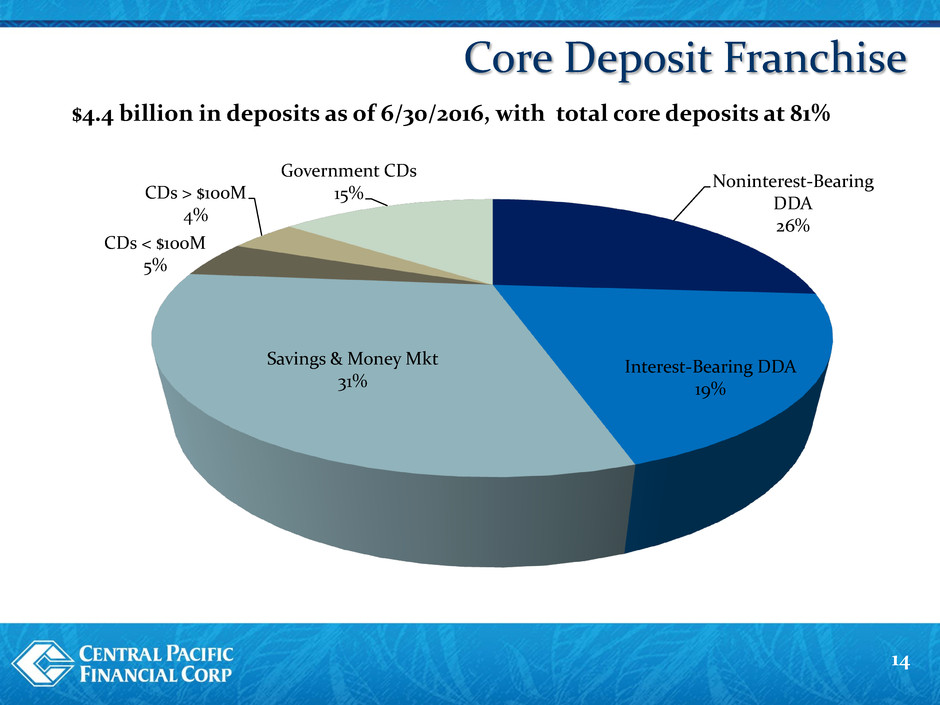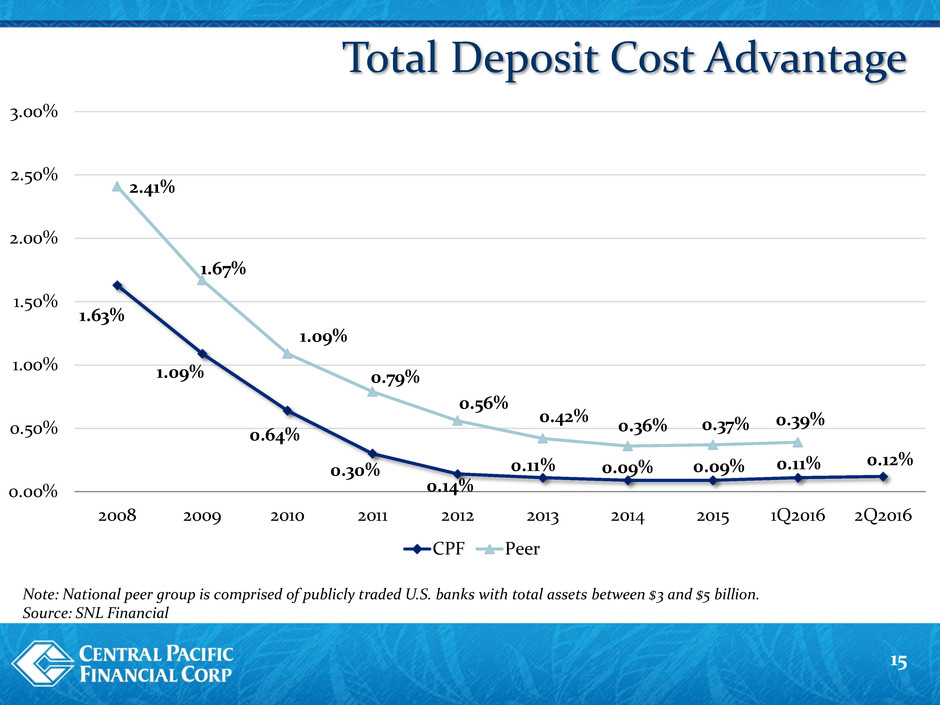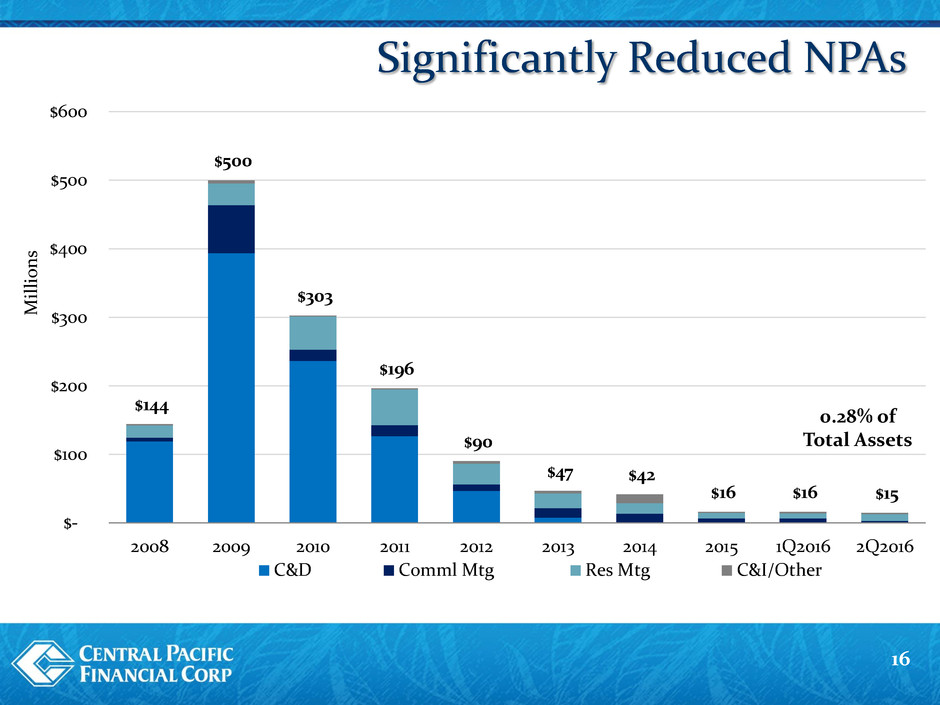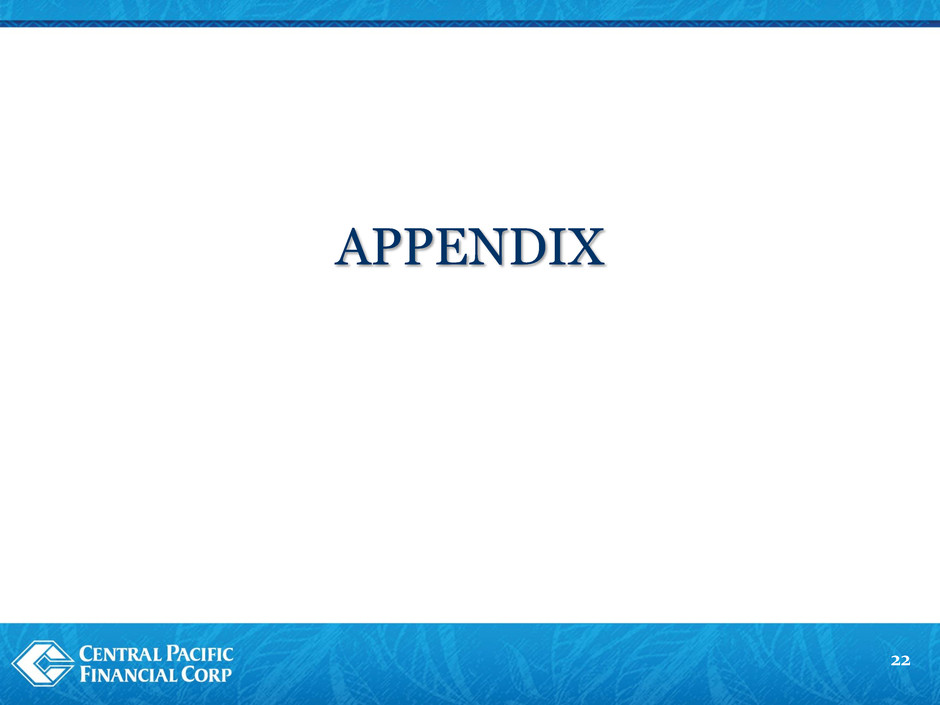Attached files
| file | filename |
|---|---|
| 8-K - 8-K - CENTRAL PACIFIC FINANCIAL CORP | a8-kaugust2016.htm |

A. CATHERINE NGO
President & Chief Executive Officer
DAVID S. MORIMOTO
Executive Vice President & Chief
Financial Officer
August 2016

Forward-Looking Statements
1
This presentation may contain forward-looking statements concerning: projections of revenues, income/loss, earnings/loss per share, capital
expenditures, dividends, capital structure, or other financial items, plans and objectives of management for future operations, future economic
performance, or any of the assumptions underlying or relating to any of the foregoing. Forward-looking statements can be identified by the fact
that they do not relate strictly to historical or current facts, and may include the words “believes,” “plans,” “intends,” “expects,” “anticipates,”
“forecasts,” “hopes,” “should,” “estimates”, “may”, “will”, “target” or words of similar meaning. While we believe that our forward-looking
statements and the assumptions underlying them are reasonably based, such statements and assumptions are by their nature subject to risks and
uncertainties, and thus could later prove to be inaccurate or incorrect. Accordingly, actual results could materially differ from forward-looking
statements for a variety of reasons, including, but not be limited to: an increase in inventory or adverse conditions in the Hawaii and California real
estate markets and deterioration in the construction industry; adverse changes in the financial performance and/or condition of our borrowers
and, as a result, increased loan delinquency rates, deterioration in asset quality, and losses in our loan portfolio; the impact of local, national, and
international economies and events (including natural disasters such as wildfires, tsunamis, storms and earthquakes) on the Company’s business
and operations and on tourism, the military, and other major industries operating within the Hawaii market and any other markets in which the
Company does business; deterioration or malaise in domestic economic conditions, including destabilization in the financial industry and
deterioration of the real estate market, as well as the impact of declining levels of consumer and business confidence in the state of the economy in
general and in financial institutions in particular; changes in estimates of future reserve requirements based upon the periodic review thereof
under relevant regulatory and accounting requirements; the impact of the Dodd-Frank Wall Street Reform and Consumer Protection Act, changes
in capital standards, other regulatory reform, including but not limited to regulations promulgated by the Consumer Financial Protection Bureau,
government-sponsored enterprise reform, and any related rules and regulations on our business operations and competitiveness; the costs and
effects of legal and regulatory developments, including the resolution of legal proceedings or regulatory or other governmental inquiries and the
results of regulatory examinations or reviews; ability to successfully implement our initiatives to lower our efficiency ratio; the effects of and
changes in trade, monetary and fiscal policies and laws, including the interest rate policies of the Board of Governors of the Federal Reserve
System; inflation, interest rate, securities market and monetary fluctuations; negative trends in our market capitalization and adverse changes in
the price of the Company’s common shares; political instability; acts of war or terrorism; changes in consumer spending, borrowings and savings
habits; failure to maintain effective internal control over financial reporting or disclosure controls and procedures; technological changes; changes
in the competitive environment among financial holding companies and other financial service providers; the effect of changes in accounting
policies and practices, as may be adopted by the regulatory agencies, as well as the Public Company Accounting Oversight Board, the Financial
Accounting Standards Board and other accounting standard setters; our ability to attract and retain skilled employees; changes in our
organization, compensation and benefit plans; and our success at managing the risks involved in the foregoing items. For further information on
factors that could cause actual results to materially differ from forward-looking statements, please see the Company’s publicly available Securities
and Exchange Commission filings, including the Company’s Form 10-K for the fiscal year ended December 31, 2015, and, in particular, the
discussion of “Risk Factors” set forth therein. The Company does not update any of its forward-looking statements except as required by law.

Corporate Profile
2
Founded in 1954 by Japanese-American veterans
of World War II
Fourth largest financial institution in Hawaii.
2011: $345 million recapitalization, including rights offering.
Profitable every quarter since recapitalization
CPF stock price is up ~ 145% from recapitalization; CAGR of 17%
3Q2013-2Q2016: Returned $300 million to shareholders through
repurchase of $245 million of CPF common stock and aggregate
cash dividends of $55 million.
Today: NYSE market capitalization of approximately $760 million.
Total assets of $5.3 billion Deposit market share of 11%
Note: Market data as of July 22, 2016.

Net income of $12.1 million and ROA of 0.93%.
Total loans increased by $398 million, or 13% and total
deposits increased by $223 million, or 5% from the prior
year.
Relatively stable net interest margin of 3.29%, compared to
3.32% in the 2Q2015.
Efficiency ratio of 66.7%, compared to 71.5% in the year ago
quarter.
Increased the quarterly cash dividend to $0.16 per share,
representing a 2.6% dividend yield.
Second Quarter 2016 Highlights
3
Note: Market data as of July 22, 2016.

Shareholder Value Drivers
4
Strong Hawaii Market
Relationship Banking Growth
Opportunities
Asset Quality Improvements
Technology & Efficiency
Enhancements
Capital Optimization

Population of 1.4 million (2015).
Four major islands – Oahu is home to 70% of the state’s total
population.
Real State GDP (2015) $70.8 billion, +2.0% from 2014. Forecasts expect
a 2.3% increase in 2016.
State unemployment rate of 3.3% is below the national unemployment
rate of 4.9% (June 2016).
Economy driven primarily by tourism, military & real estate
construction industries.
2015 was a record year for tourism with 8.6 million visitor arrivals
(+4.1% increase from 2014) and $15.3 billion in visitor spending (2.3%
increase from 2014).
Hawaii at a Glance
5
Source: US Census Bureau, Bureau of Economic Analysis , Bureau of Labor Statistics, Hawaii
Tourism Authority and State of Hawaii Department of Business Economic Development & Tourism

Diversity of Tourism – Visitor Arrivals
6
Source: Hawaii Tourism Authority
US West
41.2%
US East
21.0%
Japan
17.6%
Canada
6.1%
Australia
4.7%
China
2.2%
Korea
2.3%
Europe
1.7%
Other
3.4%
Visitor Arrivals
2015
2015 Growth Regions
China +12%
Australia +7%
US West +7%

7
Source: Honolulu Board of Realtors & National Association of Realtors . Data as of June 2016.
Strong Real Estate Market
$760.0
$249.8
$100.0
$200.0
$300.0
$400.0
$500.0
$600.0
$700.0
$800.0
2006 2007 2008 2009 2010 2011 2012 2013 2014 2015 2016
T
h
ous
an
d
s
Existing Single Family Home Median Sales Price
Oahu U.S.

Continued Growth and Development
8
1. Residential High-Rise Condominium Development in Honolulu
Proposed master plan includes 22 new high-rise towers in Honolulu.
Thirteen developments have completed successful sales and begun construction or have
completed construction over the past few years.
2. Rail Construction
$7.5+ billion, 20-mile route. First section scheduled to be completed in early 2019 and
full route to be in operation by 2021.
3. Modernization of Honolulu International Airport
$1.7 billion effort that began in 2013 and is expected to be completed by the end of 2020.
4. Military Construction
Hawaii was approved for more than $470 million in military construction spending and
infrastructure investment for fiscal year 2016 as part of the National Defense
Authorization Act.
5. International Market Place Redevelopment in Waikiki
$350 million project that started in 2014 to develop 360,000 s.f. mall anchored by the
state’s first Saks Fifth Avenue store is targeted to open on August 25, 2016.
Source: Honolulu Star Advertiser, Hawaii Community Development Authority, Honolulu Rail Transit, Hawaii Airports Modernization,
Pacific Business News.

Continued Growth and Development
9

Hawaii Banking Market
Note: Deposit data as of March 31, 2016. For consistency, total deposits at the regulated depository level.
Source: SNL Financial
10
Total
Deposits Market
Rank Institution Type Ownership Branches (millions) Share
1 First Hawaiian Bank Bank Private - BNP 62 $16,054 38.3%
2 Bank of Hawaii Bank Public 70 13,545 32.3%
3 American Savings Bank Savings Bank Private - HEI 55 5,179 12.4%
4 Central Pacific Bank Bank Public 35 4,497 10.7%
5 Territorial Savings Bank Savings Bank Public 29 1,501 3.6%
6 Hawaii National Bank Bank Private 14 587 1.4%
7 Finance Factors Bank Private 13 420 1.0%
8 Ohana Pacific Bank Bank Private 2 103 0.2%
Market Total 280 $41,886

Kauai (2)
Oahu (27)
Maui (4)
Hawaii (2)
CPB Branch Positioning
($ millions) June 30, 2016
11
Total Assets $5,283
Total Loans $3,404
Total Deposits $4,405
Total Branches 35

Relationship Banking Growth Opportunities
12
Launched a customer experience
initiative to create a competitive
advantage and differentiate ourselves
from the rest of the market.
Identified and focused on targeted
market niches.
Established a strategic alliance with a
regional bank in Japan to develop more
relationships with Japanese businesses
and high net worth individuals.
Developed additional joint ventures with
local real estate companies and
developers.

$4,030
$3,042
$2,169 $2,064
$2,204
$2,631
$2,932
$3,212 $3,309
$3,404
$-
$500
$1,000
$1,500
$2,000
$2,500
$3,000
$3,500
$4,000
$4,500
2008 2009 2010 2011 2012 2013 2014 2015 1Q2016 2Q2016
Balances Outstanding
Comml Mtg Construct/Dev C&I Consumer/Other Res Mtg
Million
s
Strong Loan Growth
13
YTD 2016 net growth of $192 million, or 6.0% unannualized.
4.5 Yr
CAGR
+15%
+38%
+23%
-11%
+1%

Core Deposit Franchise
14
$4.4 billion in deposits as of 6/30/2016, with total core deposits at 81%
Noninterest-Bearing
DDA
26%
Interest-Bearing DDA
19%
Savings & Money Mkt
31%
CDs < $100M
5%
CDs > $100M
4%
Government CDs
15%

Total Deposit Cost Advantage
15
Note: National peer group is comprised of publicly traded U.S. banks with total assets between $3 and $5 billion.
Source: SNL Financial
1.63%
1.09%
0.64%
0.30%
0.14%
0.11% 0.09% 0.09% 0.11% 0.12%
2.41%
1.67%
1.09%
0.79%
0.56%
0.42% 0.36% 0.37% 0.39%
0.00%
0.50%
1.00%
1.50%
2.00%
2.50%
3.00%
2008 2009 2010 2011 2012 2013 2014 2015 1Q2016 2Q2016
CPF Peer

$144
$500
$303
$196
$90
$47 $42
$16 $16 $15
$-
$100
$200
$300
$400
$500
$600
2008 2009 2010 2011 2012 2013 2014 2015 1Q2016 2Q2016
Million
s
C&D Comml Mtg Res Mtg C&I/Other
Significantly Reduced NPAs
16
0.28% of
Total Assets

Strong Reserve Coverage
17
Note: National peer group is comprised of publicly traded U.S. banks with total assets between $3 and $5 billion.
Source: SNL Financial
2.97%
6.75%
8.89%
5.91%
4.37%
3.19%
2.53% 1.97% 1.88% 1.79% 1.50%
1.93%
1.97% 1.82%
1.61% 1.44%
1.22% 1.07% 1.04%
0.00%
1.00%
2.00%
3.00%
4.00%
5.00%
6.00%
7.00%
8.00%
9.00%
10.00%
ALLL/Total Loans
CPF Peer

Technology & Efficiency Enhancements
18
2014/
2015
Completed
2016
Underway
Core System Outsource – Focus on core competency of relationship
banking and outsource non-core tasks where feasible.
Items Processing Outsource – Under declining processing volumes,
converted IP related fixed costs to variable costs.
Teller & Sales Branch Automation – Upgraded to D+H Encore Teller
& Sales system to improve branch efficiency and improve sales.
Branch Optimization – Consolidated 2 Waikiki branches and
consolidated University branch into another nearby branch.
Enterprise Data Warehouse – Partnered with IBM to develop EDW,
which was launched on July 1, 2016.
Data & Predictive Analytics - Next Best Offer, improved customer
targeting and enhanced direct marketing response rates.
Customer Relationship Management System – Single view of
customer relationship, history and individualized needs assessment.

40%
60%
80%
100%
120%
2008 2009 2010 2011 2012 2013 2014 2015 1Q2016 2Q2016
Efficiency Ratio
Targeting Improved Efficiency Ratio
19
Normalize balance sheet composition and net interest income over time.
Improve efficiencies by leveraging data warehouse and branch automation
functionalities.
Enhance customer profitability post-development of CRM and predictive analytics.
Identify staffing and occupancy optimization opportunities through benchmarking
and efficiency studies.
2Q2016 Efficiency
Ratio: 66.69%

Capital Optimization
20
Reinstated quarterly cash dividend of $0.08 per share in 3Q2013.
Increased cash dividend by 25% in 3Q2014, 20% in 1Q2015, 17% in
4Q2015 and 14% in 3Q2016.
Aggregate cash dividends of $55 million returned to our
shareholders since 3Q2013.
Share repurchase activity to optimize the capital structure.
Repurchased over 11 million shares of CPF common stock at a total
cost of $245 million through 2Q2016.
Capital ratios remain strong as of 6/30/2016:
Common Equity Tier 1 Capital: 12.5% Total Risk Based Capital: 15.9%
Tier 1 Risk Based Capital: 14.6% Tier 1 Leverage Capital: 10.8%

Shareholder Value Drivers
21
Strong Hawaii Market
Relationship Banking Growth
Opportunities
Asset Quality Improvements
Technology & Efficiency
Enhancements
Capital Optimization

APPENDIX
22

Financial Highlights
23
($ in millions)
6/30/2016 3/31/2016 2015 2014 2013 2012 2011
Balance Sheet (period end data)
Loans and leases $3,403.9 $3,309.0 $3,211.5 $2,932.2 $2,630.6 $2,203.9 $2,064.4
Total assets 5,283.0 5,242.2 5,131.3 4,853.0 4,741.2 4,370.4 4,132.9
Total deposits 4,405.1 4,496.6 4,433.4 4,110.3 3,936.2 3,680.8 3,443.5
Total shareholders' equity 517.6 509.4 494.6 568.0 660.1 504.8 456.4
Income Statement
Net interest income $39.6 $39.2 $149.5 $143.4 $133.1 $119.7 $117.8
Provision (credit) for loan & lease losses (1.3) (0.7) (15.7) (6.4) (11.3) (18.9) (40.7)
Other operating income 11.7 10.2 39.0 43.8 54.9 55.7 50.2
Other operating expense (excl goodwill) 34.2 32.9 131.2 132.8 139.5 146.9 172.1
Income taxes (benefit) 6.3 6.0 27.1 20.3 (112.2) 0.0 0.0
Net income 12.1 11.2 45.9 40.5 172.1 47.4 36.6
Profitability
Return on average assets 0.93% 0.87% 0.92% 0.85% 3.73% 1.13% 0.90%
Return on avg shareholders' equity 9.51% 8.85% 8.91% 6.80% 27.70% 9.81% 9.83%
Efficiency ratio 66.69% 66.58% 69.61% 70.93% 74.20% 84.19% 102.36%
Net interest margin 3.29% 3.33% 3.30% 3.32% 3.19% 3.10% 3.09%
Capital Adequacy (period end data)
Tier 1 leverage capital ratio 10.8% 10.8% 10.7% 12.0% 13.7% 14.3% 13.8%
Total risk-based capital ratio 15.9% 15.8% 15.7% 18.2% 21.6% 23.8% 24.2%
Asset Quality
Net loan charge-offs/avg loans 0.00% 0.05% -0.16% 0.12% 0.05% 0.32% 1.42%
Nonaccrual loans/total loans (period end) 0.41% 0.44% 0.44% 1.33% 1.58% 3.60% 6.49%
Year Ended December 31,3mos ended

Loan and Credit Composition
24
($ in Millions)
Balance % Balance % $ %
Hawaii Portfolio
Residential Mortgage $1,502 44% $1,352 45% $150 11%
Commercial Mortgage 716 21% 588 20% 128 22%
Commercial & Ind/Leasing 360 11% 342 11% 18 5%
Construction 95 3% 80 3% 15 19%
Consumer & Other 279 8% 257 8% 22 9%
Total Hawaii Portfolio $2,952 87% $2,619 87% $333 13%
Mainland Portfolio
Commercial Mortgage $126 4% $107 4% $19 18%
Commercial & Industrial 144 4% 158 5% -14 -9%
Construction 3 0% 3 0% 0 0%
Consumer 179 5% 119 4% 60 50%
Total Mainland Portfolio $452 13% $387 13% $65 17%
Total Loan Portfolio $3,404 100% $3,006 100% $398 13%
6/30/2016 6/30/2015 Change

Stable Net Interest Margin
25
NIM has been stable for
over 2 years.
Expect NIM to be in the
3.25 t0 3.35% range over
the next couple of
quarters.
Future improvements in
the NIM will result from
continuing to grow the
loan portfolio and
stabilizing the
investment and loan
yields.
-3.41%
1.51%
-4.52%
0.22%
-5%
-4%
-3%
-2%
-1%
0%
1%
2%
12-Month Rate Sensitivities (as of 12/31)
2014 Sensitivities
2015 Sensitivities
-100 b.p. +200 b.p.
4.02%
3.62%
2.91% 3.09% 3.10% 3.19%
3.32% 3.30% 3.33% 3.29%
2.00%
2.50%
3.00%
3.50%
4.00%
4.50%
Net Interest Margin
